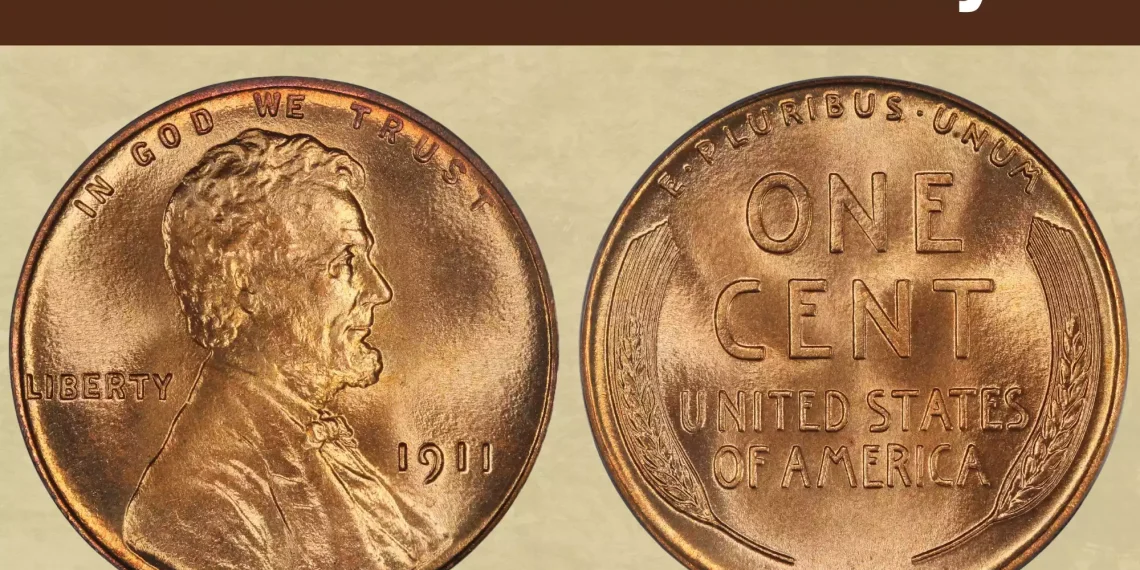The 1911 Wheat Penny value ranges from a few cents to over $1,000 depending on condition and mint mark. The 1911-S (San Francisco) is the most valuable variety, worth several thousand dollars in high-grade condition due to its low mintage of only 4 million coins. The 1911 no-mint-mark (Philadelphia) and 1911-D (Denver) versions are less rare, with the Philadelphia issue having over 101 million minted. While error coins from 1911 are uncommon, they command premium prices when found. High-grade, error-free 1911-S pennies represent the pinnacle of value for this year.
That dusty penny jar in your attic might be hiding a fortune. The 1911 Wheat Penny, a coin over a century old, ranges from pocket change to museum-quality treasures worth several thousand dollars. Whether you’ve inherited a collection or stumbled upon an old coin, understanding what makes certain 1911 pennies valuable could mean the difference between spending a few cents and cashing in on a significant windfall.
Understanding the Three 1911 Wheat Penny Varieties
The United States Mint produced Lincoln Wheat Pennies at three different facilities in 1911, each leaving its distinct fingerprint on these copper coins. The Philadelphia Mint, operating without any identifying mark, churned out over 101 million pennies that year. Denver’s facility stamped a “D” beneath the date, while San Francisco marked its coins with an “S” in the same location.
These mint marks determine more than geographic origin—they’re crucial indicators of rarity and value. The Philadelphia issue, despite its massive production numbers, isn’t considered extremely rare in circulated condition. The Denver mintage falls somewhere in the middle for scarcity. However, the San Francisco facility produced only about 4 million coins, creating what collectors now recognize as the crown jewel of 1911 pennies.
The Philadelphia No Mint Mark: Common but Potentially Valuable
Finding a 1911 penny without any mint mark means you’re holding a Philadelphia-minted coin. With over 101 million produced, these pennies circulated widely throughout the early twentieth century. Most well-worn examples from pocket change are worth just a few cents above face value—hardly enough to retire on.
The transformation happens when condition enters the equation. A 1911 Philadelphia penny that somehow escaped circulation, retaining its original mint luster and sharp design details, can command over one thousand dollars. The difference lies in preservation—coins that spent decades in drawers rather than cash registers maintained the crisp details that collectors prize.
Grading standards separate common finds from valuable specimens. Coins showing heavy wear, smooth details, and dark patina fall into the lower value range. Meanwhile, pieces with full wheat stalks visible on the reverse, sharp lettering, and original copper-red coloring represent the upper echelon of Philadelphia 1911s.
The 1911-D Denver Mint: The Middle Ground
Denver’s contribution to 1911 penny production created coins less common than Philadelphia’s massive output. The “D” mint mark sits discreetly below the date on the obverse side, requiring careful examination to confirm authenticity.
Value patterns for Denver-minted 1911 pennies mirror their Philadelphia counterparts in many respects. Heavily circulated examples trade for modest sums, while pristine specimens command premium prices. The key difference lies in relative scarcity—fewer Denver coins entered circulation compared to Philadelphia’s flood of copper.
Collectors seeking complete date-and-mint-mark sets create steady demand for 1911-D pennies. Higher grades particularly attract serious numismatists willing to pay substantial premiums for coins exhibiting minimal wear, original surfaces, and eye appeal that separates exceptional pieces from ordinary survivors.
The 1911-S San Francisco: The Trophy Coin
The San Francisco Mint’s output of approximately 4 million pennies in 1911 created the scarcest regular-issue variety of that year. This low mintage, combined with heavy circulation in western states, means surviving examples in superior condition are genuinely rare.
High-grade 1911-S pennies represent serious investments, with values reaching several thousand dollars for coins in mint state condition. The dramatic price difference between worn and pristine examples makes condition absolutely critical. A heavily circulated 1911-S might trade for modest amounts, while an identical coin preserved in near-perfect condition could be worth fifty times more.
The “S” mint mark below the date confirms San Francisco origin. Authentication becomes crucial at these price levels—serious collectors should seek professional grading services to verify authenticity and condition before major purchases or sales.
Error Coins and Rare Varieties: The Wild Cards
Error coins from 1911 represent a specialized collecting niche. While dramatic errors like the famous 1943 bronze or 1944 steel pennies don’t apply to 1911 production, manufacturing mistakes did occasionally occur. These anomalies weren’t as common for the 1911 production year compared to some later dates.
When 1911 error coins surface, they command significant premiums over standard examples in equivalent condition. The specific error type and its severity determine value—dramatic mistakes visible to the naked eye typically bring higher prices than subtle variations requiring magnification to detect.
Context from other famous Wheat Penny errors, including the highly valuable 1955 double die, demonstrates how manufacturing mistakes can transform ordinary coins into extraordinary collectibles. Any 1911 penny exhibiting verified errors will substantially exceed the value of error-free counterparts in similar condition.
Maximizing Your 1911 Penny’s Value
Before selling or adding 1911 pennies to your collection, proper identification and condition assessment prove essential. Examine the area below the date with magnification to confirm mint mark presence and identity. Compare your coin’s details against grading standards—sharp features, original color, and minimal wear all contribute to higher valuations.
For potentially valuable specimens, particularly 1911-S coins or suspected errors, professional authentication and grading services provide documentation that serious buyers expect. The investment in third-party certification often returns multiples through increased buyer confidence and realized prices. Whether you’re holding a common circulated piece or a pristine San Francisco rarity, understanding these value factors transforms random pocket change into informed collecting decisions.









How much is a 1911 no mint mark wheat penny worth?
A 1911 penny with no mint mark, minted in Philadelphia, is relatively common and worth a few cents to a couple of dollars in heavily circulated condition, but can fetch $5 or more in uncirculated condition, with value increasing significantly with better condition, the presence of a strong red color, or rare errors.
What makes a 1911 wheat penny valuable?
While the 1911 Wheat Penny is not considered extremely rare, its value increases with better condition and rarity of errors. What factors affect the 1911 Wheat Penny’s value? Condition, mint mark, and the presence of errors or rare varieties primarily determine its value.
What errors to look for in wheat pennies?
Look for errors like doubled dies (visible as double images on lettering or the date) and repunched mint marks (a mint mark that appears to have been punched over another). Other errors include off-center strikes, clipped planchets (coins with a curved edge where metal was removed), and strikes on the wrong metal planchet, such as a 1943 copper version or a 1944 steel version.
How much is the rare Lincoln wheat penny worth?
The Lincoln Wheat Penny Valued at $110 Million, Still in Circulation. Have you ever stared at a rusty old penny and wondered if it could pay off your mortgage? In the whirlwind world of coin collecting, the Lincoln Wheat Penny—a simple one-cent coin from America’s past—fuels endless dreams of striking gold.